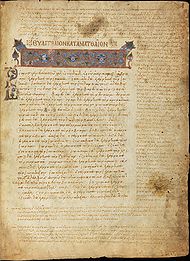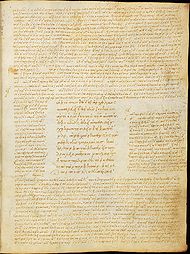- Minuscule 556
-
New Testament manuscripts
papyri • uncials • minuscules • lectionariesMinuscule 556
First page of Matthew, decorated headpiece, biblical text surrounded by a catenaText Gospels Date 12th century Script Greek Now at Bodmer Library Size 32.5 cm by 23 cm Type Byzantine text-type Category V Hand very minute Minuscule 556 (in the Gregory-Aland numbering), A 213 (in the Soden numbering),[1] is a Greek minuscule manuscript of the New Testament, on a parchment. Palaeographically it has been assigned to the 12th century.[2] Scrivener labelled it by number 526.[3]
Contents
Description
The codex contains a complete text of the four Gospels on 197 parchment leaves (size 32.5 cm by 23 cm).[2] The writing is in one column per page, 25 lines per page for the text, 61 lines for the commentary, in very minute letters.
The text is divided according to the κεφαλαια and the Ammonian Sections. The numerals of the κεφαλαια are placed at the margin, and their τιτλοι (titles) at the top. There is another divisions according to the Ammonian Sections (in Mark 239 sections – the last in 16:20) with a references to the Eusebian Canons (in gold). It contains the Synaxarion, Menologion, and pictures.[4] The headpieces for the Gospels are beautifully illuminated.[3]
The biblical text is surrounded by a catena. It contains the Pericope Adulterae (John 7:53-8:11) but without a commentary.[4]
Text
The Greek text of the codex is a representative of the Byzantine text-type. Aland placed it in Category V.[5] It was not examined by using the Claremont Profile Method was not made.[6]
History
The manuscript was brought along with seven other manuscripts (676, 677, 678, 679, 680, 681, and 682) by the late Sir Thomas Phillips, at Middle Hill in Worcestershire. These manuscripts were in the property of Mr. Fitzroy Fenwick, then at Thirlestaine House in Cheltenham.[3]
The manuscripts was added to the list of the New Testament minuscule manuscripts by F. H. A. Scrivener (526) and C. R. Gregory (556).[3][4]
The manuscript was examined by Scrivener in 1856, Dean Burgon in 1880, and Herman C. Hoskier in 1886, who quotes some of its readings.[4]
It is currently housed at the Bodmer Library (Cod. Bodmer 25) in Cologny.[2]
See also
References
- ^ Gregory, Caspar René (1908). Die griechischen Handschriften des Neuen Testament. Leipzig: J. C. Hinrichs'sche Buchhandlung. p. 67. http://www.archive.org/stream/diegriechischen00greggoog#page/n77/mode/2up.
- ^ a b c Aland, K.; M. Welte, B. Köster, K. Junack (1994). Kurzgefasste Liste der griechischen Handschriften des Neues Testaments. Berlin, New York: Walter de Gruyter. p. 79. ISBN 3110119862.
- ^ a b c d Scrivener, Frederick Henry Ambrose; Edward Miller (1894). A Plain Introduction to the Criticism of the New Testament, vol. 1 (4 ed.). London: George Bell & Sons. p. 251.
- ^ a b c d Gregory, Caspar René (1900). Textkritik des Neuen Testaments, Vol. 1. Leipzig. p. 202. http://www.archive.org/stream/textkritikdesne00greggoog#page/n215/mode/2up.
- ^ Aland, Kurt; Barbara Aland; Erroll F. Rhodes (trans.) (1995). The Text of the New Testament: An Introduction to the Critical Editions and to the Theory and Practice of Modern Textual Criticism. Grand Rapids: William B. Eerdmans Publishing Company. p. 139. ISBN 978-0-8028-4098-1.
- ^ Wisse, Frederik (1982). The profile method for the classification and evaluation of manuscript evidence, as Applied to the Continuous Greek Text of the Gospel of Luke. Grand Rapids: William B. Eerdmans Publishing Company. p. 63. ISBN 0-8028-1918-4.
Further reading
- Gregory, Caspar René (1900). Textkritik des Neuen Testaments. 1. Leipzig. p. 202. http://www.archive.org/stream/textkritikdesne00greggoog#page/n215/mode/2up.
External links
- Codex Bodmer 25 Cologny, Fondation Martin Bodmer
Categories:- Greek New Testament minuscules
- 12th-century biblical manuscripts
Wikimedia Foundation. 2010.


